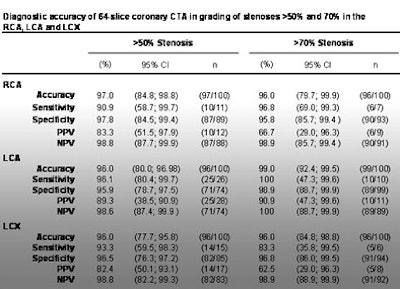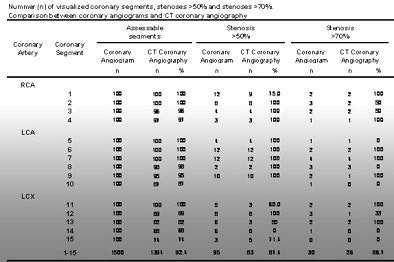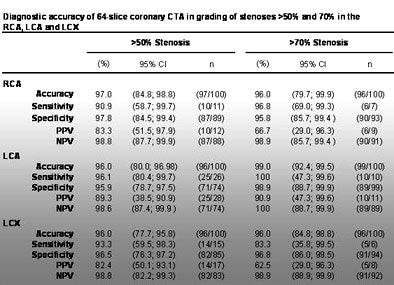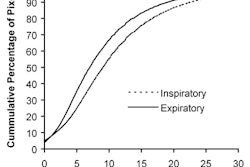
As CT piles on more detector rows, its ability to detect significant coronary artery stenosis is growing apace. Sixty-four-detector CT results are beginning to rival -- though not yet quite equal -- those of the invasive gold standard test, coronary angiography.
A new study offers evidence that CT angiography (CTA) finds nearly all patients with significant stenosis, though individual blockages can still be missed.
Researchers from Germany and the U.S. collaborated in a study of 100 patients with stable angina pectoris who underwent both coronary angiography and 64-detector CTA.
For detecting significant stenosis, four-slice CT studies generally report sensitivities in the 80th percentile. Results move into the 90% range for 16-slice CT and hopefully higher for 64-slice MDCT scanners, Dr. Christopher Herzog said in a presentation at the 2005 RSNA meeting in Chicago. But comparing the results to angiography has been unwieldy because of widely disparate study protocols, he said.
"Many studies exclude patients, many exclude vessels; some refer to vessels for measuring diagnostic accuracy, some per patient, and some per segment," Herzog said. And some studies consider significant stenosis to be 50% of the lumen diameter or greater, others 70%.
Aiming for the broadest possible view in his group's assessment, Herzog and his colleagues from Johann Wolfgang Goethe University in Frankfurt am Main, Germany, along with U. Joseph Schoepf and others from the Medical University of South Carolina in Charleston, measured their results by segment (n = 15, per American Heart Association guidelines), by vessel, and by patient.
Their study examined 100 patients with suspected coronary artery disease who underwent both conventional coronary catheter angiography and contrast-enhanced retrospectively ECG-gated CTA on a Somatom Sensation 64 scanner (Siemens Medical Solutions, Malvern, PA).
Scanning parameters included 32 x 0.6-mm collimation with double z-sampling, 0.75-mm slice thickness, 0.3-mm increment, gantry rotation time of 330 msec, temporal resolution of 83-165 msec; 50-75 mL of contrast agent (Isovue 370 mgI/mL; Bracco, Milan, Italy) injected at 5 mL/sec; and retrospective ECG-gating. IV metoprolol was administered as a beta blocker, saline washout followed the contrast injection, and automatic bolus triggering was used, Herzog added.
Two experienced observers analyzed all MDCT scans on a workstation for signs of coronary artery disease, rating the degree of stenosis into five groups: 0%, less than 50%, less than 70%, less than 99%, and 100%. MDCT's diagnostic accuracy compared to cardiac catheter was determined on a per-segment, per-vessel, and per-patient basis.
There were 95 segments with greater than 50% stenoses and 30 with greater than 70% stenoses, Herzog said. 64-slice CT was able to evaluate 92.4% of segments.
Results for all 100 patients included overall per-segment sensitivity of 87.4% for stenoses 50% or greater, and 86.7% for stenoses 70% and greater. Accuracy for all three vessels was comparable, between 97% to 99% for the right coronary artery, left coronary artery, and left circumflex artery.
 |
| Results in 100 patients show high per-patient accuracy, lower accuracy by individual vessel and segment. All images courtesy of Dr. Christopher Herzog. |
 |
 |
"What you can see is that sensitivity on a per-segment basis is not really that high, but increases per vessel and per patient," Herzog said of the results. "All patients with a 50% stenosis were detected. One patient with a 70% stenosis was missed, but this patient had a very significant 50% stenosis that was detected."
Overall, 64-slice CTA provides good diagnostic accuracy for detecting significant stenosis, per patient, he said. Despite improved spatial and temporal resolution, however, CTA is "still a little impaired on a per-segment and per-vessel basis," in which motion artifacts and misregistration limit the image quality and the diagnostic accuracy of this technique compared to catheter angiography.
By Eric Barnes
AuntMinnie.com staff writer
March 23, 2006
Related Reading
How 64-slice CT saved my life -- A radiologist's story, February 7, 2006
CT angiography runs circles around stress testing, February 7, 2006
Step-and-shoot acquisition cuts CTA dose, improves images, January 16, 2006
Coronary CTA requires dedication, 64-slice minimum, November 30, 2005
64 CT slices beat 16 for stenosis and diagnosis of heart disease, November 27, 2005
Copyright © 2006 AuntMinnie.com



















